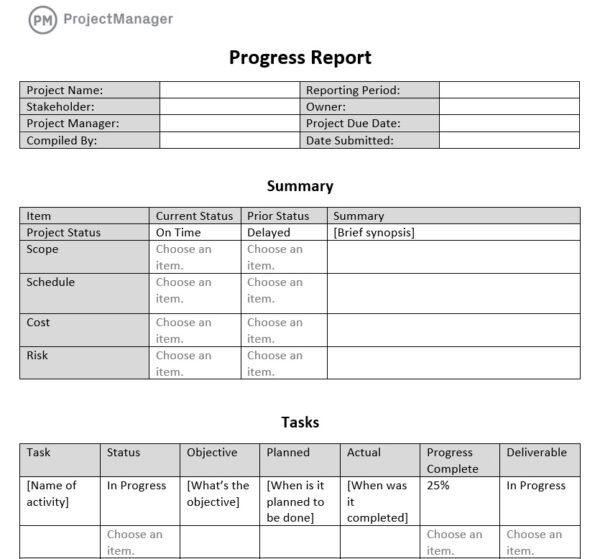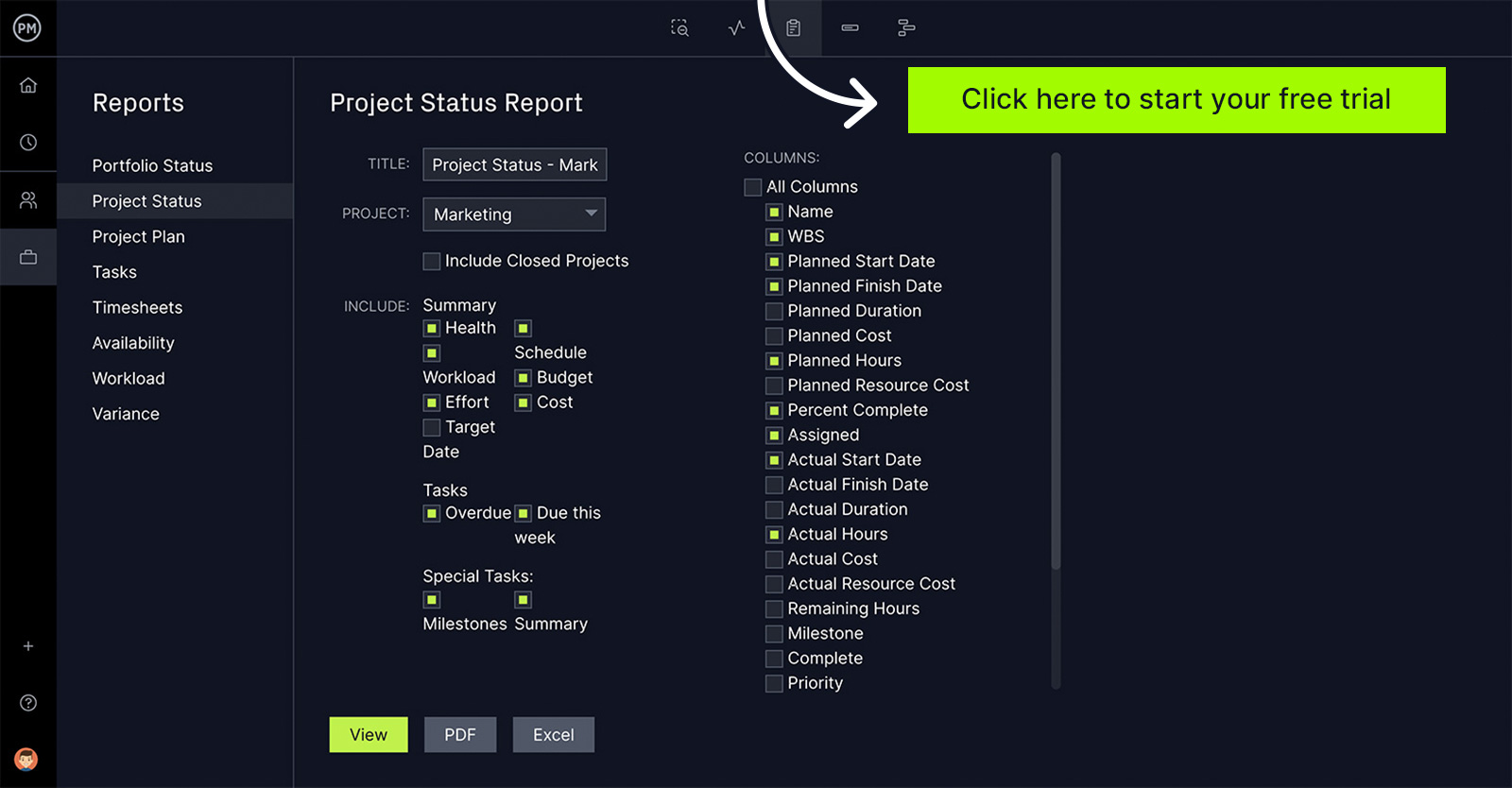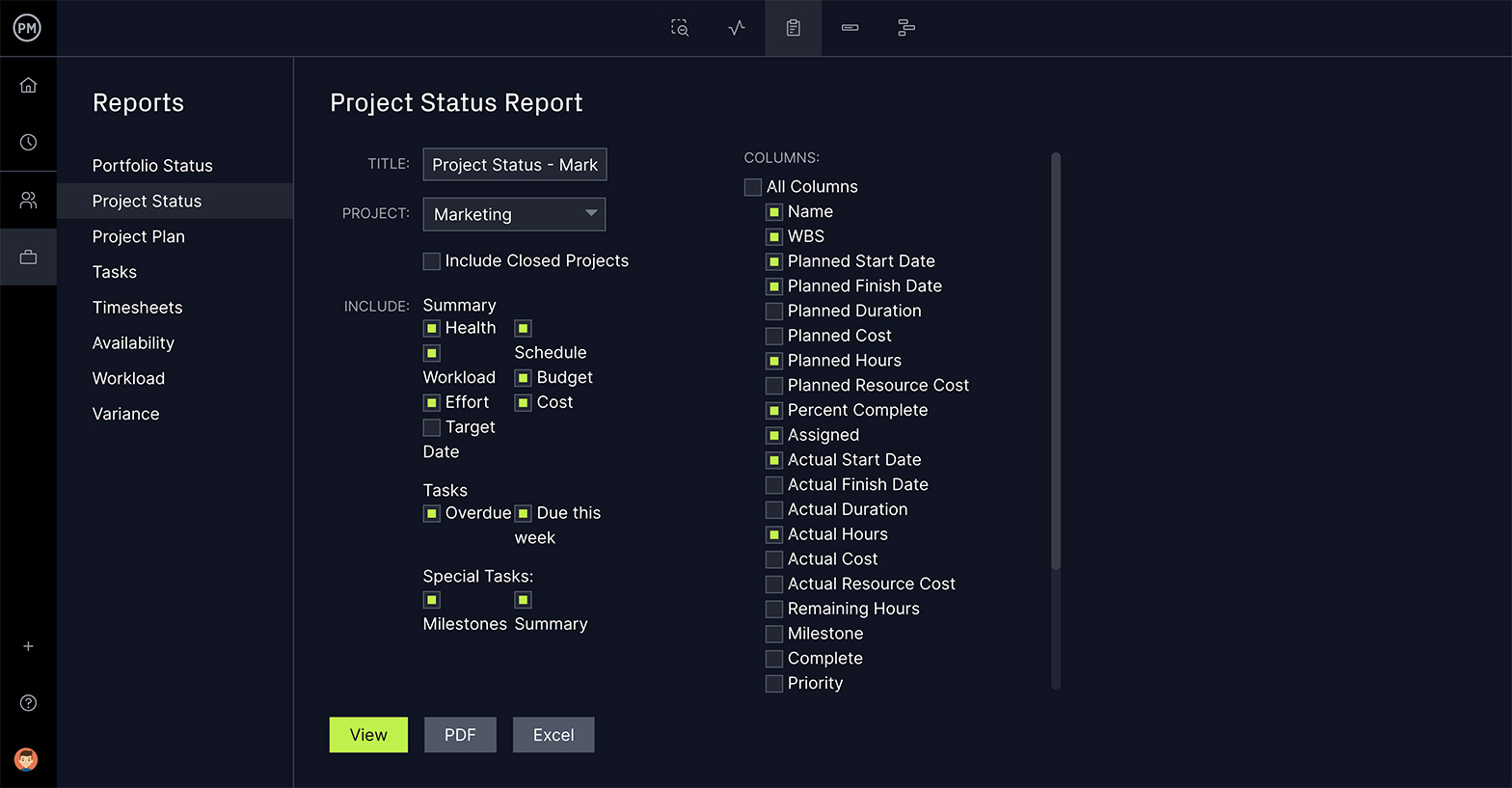Periodically, you’re going to need to report on the progress of your project. Not a status report, but a picture of the project and its movement over the course of a specific amount of time. Whether that’s a week or a month, you’re going to need a template to capture the pertinent information.
Use our free progress report template to make that job easier. With our progress report template for Word, all you have to do is open the document, fill out the blank fields and share it with your stakeholders. Get started by downloading the template.
What Is a Project Progress Report?
A progress report documents the project and shows how far it has progressed in comparison to where the project plan expected it to be. It serves as a snapshot of the project’s progress within a specific period of time.
The progress report provides an overview of all the activities and tasks that have occurred over the reported period of time. It highlights milestones and other performance metrics, including risks, issues, changes, etc.

It’s important to know that a progress report differs from a status report because a status report only outlines where the project stands at a specific point in time. The progress report differentiates itself because its temporal focus is wider. For example, a weekly activity report is a progress report because it’s defined by that week-long date range.
Why Use a Progress Report Template?
Our progress report template saves time and lessens the effort of reporting. All the information you have to collect is already laid out for you in the document. All you need to do is add the specific details as they relate to your project.
The progress report is also a tool to communicate to your stakeholders and clients that the project is moving forward as planned. In a sense, it’s a persuasive tool to appease any anxiety or concerns they have over the project’s progress. Ideally, the progress report shows that the project is going as planned and will deliver as expected. Of course, if this is not the case, then the progress report will explain the reason for the delays and what is being done to rectify these issues.
Our progress report template also opens up discussions about problems that the project manager is facing and gives that information to the stakeholders sooner rather than later. The project manager also benefits by being forced to create a work schedule that is flexible enough to adjust to issues or just deliver the project on time.
For greater flexibility, you need a progress report that gets metrics directly from the project. ProjectManager is project management software that sources live project data for more insightful decision-making. Create status reports with one click, and customize them to reveal just the information you need. But we offer more than status reports: use our automated dashboards and reporting features for a deep look into portfolios, project plans, tasks, timesheets, team availability, workload and project variance. Imagine the time you’ll save when you automate your project reporting process. Try it free today!

Who Uses a Progress Report Template?
The project progress report template is a key line of communication between the project manager and the project’s stakeholders. It is compiled by the project manager, or in some cases, an assistant to the project manager.
However, the information is often collected through interviewing team members and the data is logged through software or the old-fashioned way. But either way, that means that the progress report is used by pretty much anyone on the project team.
That’s true not only for creating one but after it’s been made. At this point, the stakeholder can get a look at the progress of the project over a period of time. It is also a way to get the team looking at how they’ve progressed and what they might do in order to get better results for the next reporting period.
How to Use Our Project Progress Report Template
The progress report template captures the project over the course of a specific time period, which means there’s lots of data. Using our free progress report template is a way to organize all the information so that you don’t overlook anything important or add anything trivial.
Project Top Line Information
The top of the progress report template captures the overall details, such as the project’s name, who the stakeholders are and the project manager. Then there’s a space to add the period that is being reported on, who compiled it and when it was submitted. There’s also a place to note the deadline for the final deliverable to place the report in context.
Summary
While the whole progress report template is a way to distill the events of the period covered into digestible bits, there’s a summary on top of that to give the big picture. This section shows the current progress for the overall project status, its scope, schedule, cost and risk.
There is a dropdown menu to make this easier. Then there is another column with a dropdown menu that shows the prior status so you can compare. The last column allows you to write a brief summary to explain the status.
Tasks
In this section, you can list all the tasks that were executed over the period discussed in the progress report template. The columns let you name the task being tracked, what its status is and objective. There’s a column for the date it’s due, according to the project plan and then the actual date it was completed.
If it’s not complete, there’s a column for noting the percentage it is complete. Finally, the last column lets you note the state of your deliverable if it’s done, in progress or hasn’t yet been started.
Issues
There are always risks inherent in every project, though these issues might not always arise during the reporting periods. However, they might, which is why the next section provides space to identify the issues and who found it. Note what actions need to take place or if the issue is minor enough that it won’t impact the project and can be left alone.
Budget
Here’s where the all-important expenditure is captured. There’s a column for the line item in your budget, followed by the total money allocated for that item, what was spent over the course of the reporting period and then the total expenditure to date in the project.
Accomplishments
If there are any accomplishments that don’t fall under the above categories, they can be listed here. This can include any activities, meetings or other things that the project achieves and are notable enough to be reported on.
Expected Accomplishments
The progress report template ends with a look forward to the next reporting period. It allows you to set expectations for your stakeholders.
Other Reporting Templates That Can Help
The free progress report template is only one of the dozens of project management templates that can be downloaded from our site. We have several that deal with reporting and have highlighted a few.
Change Request Form
One result of using a progress report is that stakeholders come back with changes. To manage those changes to keep within the scope of your project, use our free change request form. It’s a fundamental pillar in building a successful change management process.
Status Report Template
A status report, as mentioned above, is not exactly the same as a progress report. Our free status report is a snapshot of the project that captures that one moment in time rather than a period of time, such as in the progress report. Status reports are a way to communicate with your stakeholders when they want something, now.
Lessons Learned Template
Not a report per se, but a great template to capture what you’ve learned from the progress report to avoid making similar mistakes as you move forward in the project. Our free lessons learned template can be used at the end of the project as a post mortem but it can be equally useful after you present your progress report to help you make incremental changes during the execution of the project.
How ProjectManager Improves Reporting
Templates are great, but they are limited. They are not dynamic and aren’t connected with your project management tools. Plus, they can get lost in the shuffle if you’re not using digital templates.
ProjectManager is award-winning software that helps organize tasks, teams and projects with the reporting tools you need to graduate from simple templates. Our robust reporting features do everything your progress report template does, faster and easier.

When you need to create a progress report use our one-click reporting feature. You can create status reports, reports on budgets, even timesheets and much more. These reports are more up-to-date, can be shared with a keystroke and they can even be filtered to show stakeholders just what they want.
First, because our software is cloud-based, all your teams are connected no matter where they are. As they update their statuses that data is collected on the tool so monitoring and reporting is accurate and up to the minute.
Related Content
If you’re looking for more information on project reporting, we published a project management blog, have tutorial videos and free guide books about every aspect of project management on our site. It’s a great resource. Here are a few we picked to get you started.
- Free Project Report Templates
- What Is a Project Deliverable? Definition, Examples & More
- How to Write a Scope of Work (Example Included)
- 8 Steps for Better Issue Management
ProjectManager is a cloud-based project management solution that helps you plan, monitor and report on your project. Online Gantt charts give project managers control over their schedule and kanban board’s visual workflow for greater transparency. Teams get a collaborative platform to work better together no matter where they are. See how we can help you run a tighter project by taking our free 30-day trial today.
